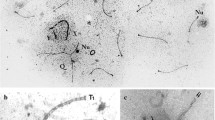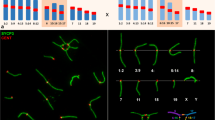Abstract
Synaptonemal complexes (SCs) in surface spread pachytene spermatocytes of Lemur resemble those in other mammals and are of two types: metacentric (or submetacentric) and acrocentric, with a very short second arm. In autosomal SC and mitotic karyotypes of Lemur fulvus (2n=60) a 1∶1 proportionality in relative length is observed as in other mammals. In an intraspecific lemur hybrid (2n=55) obtained by mating L. fulvus rufus (2n=60) x L. fulvus collaris (2n=51), G-band patterns show that 10 single acrocentric mitotic chromosomes correspond to the arms of 5 single metacentrics, implying homology. It is inferred that the metacentrics have evolved by centric (Robertsonian) fusion of the acrocentrics. In the SC karyotype of the hybrid all SCs are normal except for five which have the configurations expected of metacentric-acrocentric trivalents. Similarly, in L. f. collaris (2n= 51), with one unpaired metacentric and two unpaired acrocentrics, one such SC trivalent is present in the complement. In an SC trivalent, each of the acrocentric long axes is synapsed with an arm of the metacentric axis, confirming the homology predicted from banding similarities. At late zygotene, the acrocentric short arms, which are non-homologous, are the last to pair, demonstrating that synapsis of the homologous arms occurs first. At later pachytene the acrocentric short arms are fully synapsed, producing a short SC side arm. This subsequent non-homologous synapsis is taken to be an instance of the synaptic adjustment phenomenon which has been shown to lead to non-homologous synapsis in a duplication and several inversions in the mouse. The kinetochore of the metacentric is the same size as those of the acrocentrics, and thus is unlikely to have arisen by true centromeric fusion, but rather by a translocation. The kinetochores of the acrocentrics always lie together on the same side of the metacentric kinetochore (cis configuration), implying a single pairing face on the metacentric axis. The observed trivalent configuration may well constitute a prerequisite for proper meiotic disjunction in metacentric-acrocentric heterozygotes. Such a mechanism is consistent with fertility regularly observed in such hybrid lemurs.
Similar content being viewed by others
References
Arrighi, F.E., Hsu, T.C.: Constitutive heterochromatin and Giemsa crossbands of mammalian chromosomes. In: Human chromosome methodology (J.J. Yunis, ed.), pp. 59–71. New York: Academic Press (1974)
Chu, E.H.Y., Bender, M.A.: Chromosome cytology and evolution in primates. Science 133, 1399–1405 (1961)
Chu, E.H.Y., Swomley, B.A.: Chromosomes of lemurine lemurs. Science 133, 1925–1926 (1961)
Counce, S.J., Meyer, G.F.: Differentiation of the synaptonemal complex and the kinetochore in Locusta spermatocytes studied by whole mount electron microscopy. Chromosoma (Berl.) 44, 231–253 (1973)
Dutrillaux, B., Rumpler, Y.: Chromosomal evolution in Malagasy lemurs. II. Meiosis in intra and interspecific hybrids in the genus Lemur. Cytogenet. Cell Genet. 18, 197–211 (1977)
Hamilton, A.E.: G-banding patterns and chromosome vevolution in the genus Lemur. Amer. J. phys. Anthropol. 42, 3052 (1975)
Hamilton, A.E.: Karyotype evolution in Lemur: the G-banded chromosomes of species, subspecies and hybrids. Ph. D. thesis, Duke University, pp. 1–214. 1977
Hamilton, A.E., Buettner-Janusch, J.: Chromosomes of Lemuriformes. III. The genus Lemur: karyotypes of species, subspecies and hybrids. Ann. N.Y. Acad. Sci. 293, 125–159 (1977)
Hamilton, A.E., Buettner-Janusch, J., Chu, E.H.Y.: Chromosomes of Lemuriformes: II. Chromosome polymorphism in Lemur fulvus collaris (E. Geoffroy 1812). Amer. J. phys. Anthropol. 46, 395–406 (1977)
John, B., Freeman, M.: Causes and consequences of Robertsonian exchange. Chromosoma (Berl.) 52, 123–136 (1975)
Matthey, R.: Les chromosomes des vertébrés. Lauzanne: F. Rouge 1949
Menzel, M.Y., Price, J.M.: Fine structure of synapsed chromosomes in F1 Lycopersicon esculentum — Solanum lycopersicoides and its parents. Amer. J. Bot. 53, 1079–1086 (1966)
Moens, P.B.: Kinetochores of grasshoppers with Robertsonian chromosome fusions. Chromosoma (Berl.) 67, 41–54 (1978)
Moses, M.J.: Synaptinemal complex. Ann. Rev. Genet. 2, 363–412 (1968)
Moses, M.J.: Synaptonemal complex karyotyping in spermatocytes of the Chinese hamster (Cricetulus griseus). I. Morphology of the autosomal complement in spread preparations. Chromosoma (Berl.) 60, 99–125 (1977a)
Moses, M.J.: Synaptonemal complex karyotyping in spermatocytes of the Chinese hamster (Cricetulus griseus) II. Morphology of the XY pair in spread preparations. Chromosoma (Berl.) 60, 127–137 (1977b)
Moses, M.J.: The synaptonemal complex and meiosis. In: Molecular human cytogenetics (R.S. Sparkes, D. Comings and C.F. Fox, eds.), pp. 101–125. New York: Academic Press 1977c
Moses, M.J.: Microspreading and the synaptonemal complex in cytogenetic studies. In: Chromosomes today 6, 71–82 (1977d)
Moses, M.J., Counce, S.J.: Synaptonemal complex karyotyping in spreads of mammalian spermatocytes. In: Mechanisms in recombination (R.F. Grell, ed.), pp. 385–390. New York: Plenum Publ. Corp. 1974
Moses, M.J., Counce, S.J., Paulson, D.F.: Synaptonemal complex complement of man in spreads of spermatocytes, with details of the sex chromosome pair. Science 187, 363–365 (1975a)
Moses, M.J., Karatsis, P.A., Hamilton, A.E.: Metacentric-acrocentric synaptonemal complex (SC) trivalents in Lemur heterozygotes. J. Cell Biol. 67, 297a (1975b)
Moses, M.J., Russell, L.B., Cacheiro, N.L.A.: Mouse chromosome translocations: Visualization and analysis by electron microscopy of the synaptonemal complex. Science 196, 892–894 (1977a)
Moses, M.J., Slatton, G., Gambling, T., Starmer, C.F.: Synaptonemal complex karyotyping in spermatocytes of the Chinese hamster (Cricetulus griseus). III. Quantitative evaluation. Chromosoma (Berl.) 345–375 (1977)
Nicklas, R.B.: Chromosome micromanipulation II. Induced reorientation and the experimental control of segregation in meiosis. Chromosoma (Berl.) 21, 17–50 (1967)
Rasmussen, S.W.: Chromosome pairing in triploid females of Bombyx mori analyzed by three dimensional reconstructions of synaptonemal complexes. Carlsberg Res. Commun. 42, 163–197 (1977)
Rumpler, Y., Dutrillaux, B.: Chromosomal evolution in Malagasy lemurs. I. Chromosome banding studies in the genus Lemur and Microcebus. Cytogenet. Cell Genet. 17, 268–281 (1976)
Solari, A.J.: The spatial relationship of the X and Y chromosomes during meiotic prophase in mouse spermatocytes. Chromosoma (Berl.) 29, 217–236 (1970)
Solari, A.J., Ashley, T.: Ultrastructure and behavior of the achiasmatic, telosynaptic XY pair of the sand rat (Psammomys obesus). Chromosoma (Berl.) 62, 319–336 (1977)
Solari, A.J., Counce, S.J.: Synaptonemal complex karyotyping in Melanoplus differentialis. J. Cell Sci. 26, 229–250 (1977)
Solari, A.J., Moses, M.J.: Synaptonemal complexes in a tetraploid mouse spermatocyte. Exp. Cell Res. 108, 464–467 (1977)
Sun, N.C., Chu, E.H.Y., Chang, C.C.: Staining method for the banding patterns of human mitotic chromosomes. Caryologia (Firenze) 27, 315–324 (1974)
Ting, Y.C.: Synaptonemal complex of haploid maize. Cytologia (Firenze) 38, 497–500 (1973)
Tres, L.L.: Extensive pairing of the XY bivalent in mouse spermatocytes as visualized by whole mount electron microscopy. J.Cell Sci. 25, 1–15 (1977)
Author information
Authors and Affiliations
Rights and permissions
About this article
Cite this article
Moses, M.J., Karatsis, P.A. & Hamilton, A.E. Synaptonemal complex analysis of heteromorphic trivalents in Lemur hybrids. Chromosoma 70, 141–160 (1979). https://doi.org/10.1007/BF00288403
Received:
Accepted:
Issue Date:
DOI: https://doi.org/10.1007/BF00288403




